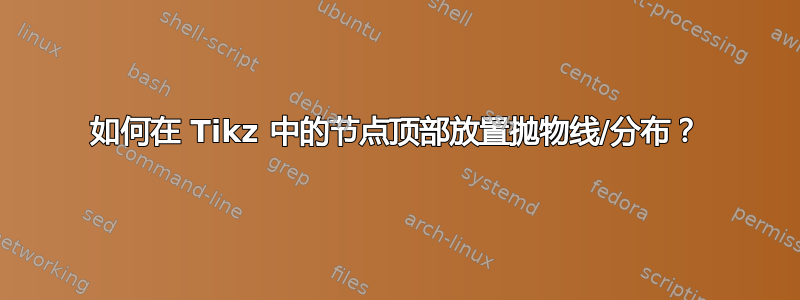
我现在正尝试将分布(最好是高斯曲线)放置在 TikzPicture 中的节点顶部。理想情况下,分布应与节点略微垂直偏移,尽管这不是必需的。我尝试扩展的代码如下:
\begin{tikzpicture}[shorten >=1pt,->,draw=black!50, node distance=2.5cm, scale=1.5]
\tikzstyle{every pin edge}=[<-,shorten <=1pt]
\tikzstyle{neuron}=[circle,fill=black!25,minimum size=17pt,inner sep=0pt]
\tikzstyle{input neuron}=[neuron, fill=green!50];
\tikzstyle{output neuron}=[neuron, fill=red!50];
\tikzstyle{hidden neuron}=[neuron, fill=blue!50];
\tikzstyle{annot} = [text width=4em, text centered]
% Draw the input layer nodes
\foreach \name / \y in {1,...,4}
% This is the same as writing \foreach \name / \y in {1/1,2/2,3/3,4/4}
\node[input neuron, pin=left:Input \y] (I-\name) at (0,-\y) {};
% Draw the hidden layer nodes
\foreach \name / \y in {1,...,5}
\path[yshift=0.5cm]
node[hidden neuron] (H-\name) at (2.5cm,-\y cm) {};
% Draw the output layer node
\node[output neuron,pin={[pin edge={->}]right:Output}, right of=H-3] (O) {};
% Connect every node in the input layer with every node in the
% hidden layer.
\foreach \source in {1,...,4}
\foreach \dest in {1,...,5}
\path (I-\source) edge (H-\dest);
% Connect every node in the hidden layer with the output layer
\foreach \source in {1,...,5}
\path (H-\source) edge (O);
% Annotate the layers
\node[annot,above of=H-1, node distance=1cm] (hl) {Hidden layer};
\node[annot,above of=I-1, node distance=1cm] {Input layer};
\node[annot,above of=O] {Output layer};
\end{tikzpicture}
导致
我理想中的情况类似于以下内容:
答案1
您可以neuron使用以下path picture命令将其嵌入到样式中:
neuron/.style={
circle,fill=black!25,minimum size=17pt,inner sep=0pt,
path picture={
\draw[red,thick,-] plot[domain=-0.3:0.3,samples=11,smooth] ({\x},{0.05*g(\x)});
},
},
我将高斯定义为
\tikzset{
declare function={
sig = 0.1;
mu = 0;
g(\x) = 1/(sig*sqrt(2*pi)) * exp(-1/2 * ((\x-mu)/sig)^2);
}
}
其结果是:
请注意,我还更改了您的\tikzstyle命令,因为它被视为已弃用。完整的 MWE:
\documentclass[tikz,margin=2mm]{standalone}
\usepackage{tikz}
\tikzset{
declare function={
sig = 0.1;
mu = 0;
g(\x) = 1/(sig*sqrt(2*pi)) * exp(-1/2 * ((\x-mu)/sig)^2);
}
}
\begin{document}
\begin{tikzpicture}[
shorten >=1pt,
->,
draw=black!50,
node distance=2.5cm,
scale=1.5,
every pin edge/.style={<-,shorten <=1pt},
neuron/.style={
circle,fill=black!25,minimum size=17pt,inner sep=0pt,
path picture={
\draw[red,thick,-] plot[domain=-0.3:0.3,samples=11,smooth] ({\x},{0.05*g(\x)});
},
},
input neuron/.style={neuron, fill=green!50},
output neuron/.style={neuron, fill=red!50},
hidden neuron/.style={neuron, fill=blue!50},
annot/.style={text width=4em, text centered},
]
% Draw the input layer nodes
\foreach \name / \y in {1,...,4}
% This is the same as writing \foreach \name / \y in {1/1,2/2,3/3,4/4}
\node[input neuron, pin=left:Input \y] (I-\name) at (0,-\y) {};
% Draw the hidden layer nodes
\foreach \name / \y in {1,...,5}
\path[yshift=0.5cm]
node[hidden neuron] (H-\name) at (2.5cm,-\y cm) {};
% Draw the output layer node
\node[output neuron,pin={[pin edge={->}]right:Output}, right of=H-3] (O) {};
% Connect every node in the input layer with every node in the
% hidden layer.
\foreach \source in {1,...,4}
\foreach \dest in {1,...,5}
\path (I-\source) edge (H-\dest);
% Connect every node in the hidden layer with the output layer
\foreach \source in {1,...,5}
\path (H-\source) edge (O);
% Annotate the layers
\node[annot,above of=H-1, node distance=1cm] (hl) {Hidden layer};
\node[annot,above of=I-1, node distance=1cm] {Input layer};
\node[annot,above of=O] {Output layer};
\end{tikzpicture}
\end{document}
答案2
代码很糟糕,但是可以工作(节点样式 - 仅在使用比例因子不等于 0 或 1 的比例盒以及一些其他错误时才有效):
\documentclass[border=.5cm,tikz]{standalone}
\tikzset{
neuron/.style={
append after command={
\pgfextra{
\node[thick,draw=blue!70,fill=blue!20,circle,inner sep=1cm] (a) at (\tikzlastnode) {};
\draw[thick,red] (a.west) parabola ([xshift=1cm,yshift=.5cm]a.west) to[bend left=50] ([xshift=-1cm,yshift=.5cm]a.east);
\draw[thick,red] (a.east) parabola ([xshift=-1cm,yshift=.5cm]a.east);
}
}
}
}
\begin{document}
\begin{tikzpicture}
\scalebox{.5}[.5]{\node[neuron] at (0,0) {};}
\end{tikzpicture}
\end{document}
输出:






